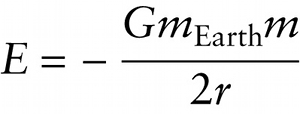Chapter 10. Total mechanical energy for circular orbit (10-13)
Question
KTiif1qBsm/b+P/MrKG/9OHRmUmg4hJKcrUlAD2t7gY7jwdFyUEOgDdMGa+bpWm6+fe4ha+U/lKr/HT7gk49/W7d4DcZmR2+B1Kqlw==
Question
2f0JqE4qJLZtiEw9M5xt/VAGtr3n12E9YgqnGA==
Question
TM0dSxyPSXvahHDc99hxQx7dHu8=
Question
gc7BDGnV8qg4wB3HHjJTpNABPBoV7F/s
Question
ls8rQUdhHdvt0fIgoZ9jJ35BE/YzOa5KZvlvkmG00sghAUrd
Question
saO/o9Gfu+XcSZMKVFk6xqOWPseDr86IoNutPKaklnkaDYX4fwc9q3/ujRzC3hcOGAJ86YOBOCxrkFtz1ZU9l1pNAOqTvIAp/pEac7HtIV6SlZxjmct3StjsPTSBpz38wITnUK2rBm+qDJZ18HayBQ==
Review
As we discussed in Section 10-3, the gravitational potential energy is negative. Making the orbital radius \(r\) larger makes the gravitational potential energy less negative—that is, closer to zero—which means that the gravitational potential energy increases. The total mechanical energy is the sum of \(K\) and \(U_{\mathrm{grav}}\):
\(E = K + U_{\mathrm{grav}} = \frac{1}{2}mv^2 + \left( - \frac{Gm_{\mathrm{Earth}}m}{r}\right) = \frac{Gm_{\mathrm{Earth}}m}{2r} + \left( - \frac{Gm_{\mathrm{Earth}}m}{r}\right) \)
or:
